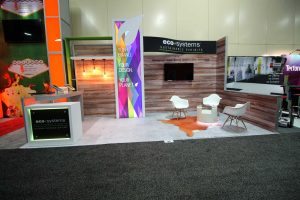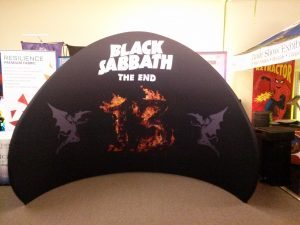Trade Show Foot Traffic: A Blessing Or A Curse?

Custom eSmart with Lightweight Recycled Aluminum Frame, LED Backlighting, and iPad Mounts on Backlit Counter.
Is trade show foot traffic a good metric to use?
If you’re a smaller exhibitor, you may be having a hard time figuring out if a particular show fits your company well.
You need to know how well you do several things:
- attract attention,
- persuade attendees to enter your booth,
- make a strong benefit statement,
- and capture the lead.
That is hard work. For many smaller exhibitors, the most common shortcut is to look to the show’s traffic density numbers. According to this theory, good trade show foot traffic density = good ROI. Bad traffic density = bad ROI.
But I don’t think it’s quite that simple. Several other factors add shades of gray to the quantity measurement—like quality, for example.
If there are more people on the trade show floor, does that mean there are more “higher quality” attendees (in terms of their value to you as an exhibitor)? If you’re at the wrong show, lots of people don’t necessarily mean lots of leads.
The answer isn’t an easy “yes.” More visitors on the show floor doesn’t always mean you’ll have more of the right kind of people in your booth.
As it turns out, there is also some truth in higher traffic density correlating with lower performance for smaller exhibitors. Why?
Because smaller exhibitors compete for the time and attention of attendees who have already seen aisles and aisles of large, attractive exhibits. The attendees you want may pass by your smaller booth – even though it’s offering great technology, because it isn’t doing a good enough job of attracting attention.
The primary reason I warn against relying on traffic density numbers is this:
- As an exhibitor, you are responsible for attracting your prospects to your exhibit and engaging with them once they get there.
- In an ideal world, the traffic density and quality of attendees should be the show organizer’s responsibility. But we don’t live in an ideal world. So you can’t just show up and expect to achieve good results.
I also believe that every exhibitor—large or small—should be able to justify their trade show spending to management.
Without the right data to provide that justification, your budget could get slashed in favor of other less expensive forms of marketing.
However, having been out on the front lines, you know when a show is worth participating in. You choose the shows you put on the company’s calendar because they deliver the best results. But just having a busy booth doesn’t tell the whole story.
If the show has high traffic density, you might attract a large number of people to your booth. So the booth looks good in pictures, but you may not write a large number of leads. A busy show floor doesn’t always get quality prospects into your exhibit.
If the show has lower traffic density, you could be attracting the right kind of people into your exhibit:
- People with a need for your product or service, the desire to buy, and the authority to make the purchase.
- At a show like this, the total number of people who pass through your exhibit may be smaller, but more of the right people will have come through.
In my own experience, working with a broad range of companies, I’ve seen a few exhibitors attract their fair share of the trade show “action.” And it honestly has nothing to do with the size of their booth.
I think it starts with making sure you have a strong enough product in your exhibit to attract the highest quality attendees.
If your booth looks cheesy and your product line is tired, you’re never going to attract top-tier visitors.
So you have to look like a winner to be a winner. Then you have to be able to back up your looks with your products. Both need to be top notch, if you have any hope of getting the right people into your exhibit.
I’ve often suggested to clients that they think about the ideal attendee they want to attract. Then, consider their wants and needs, and build backwards from that. Finally, target your marketing by finding out where your ideal attendee gets information. Then, use those sources to promote your message.
In other words, with an effective pre-show marketing program, you can reach out to your target audience and make them want to stop by your exhibit.
That way, whether the trade show foot traffic density is for you or against you, you’ll still be connecting with that group of attendees you want as your customers.
There are good reasons for tracking traffic density at the shows where you exhibit. But I always tell my clients to not leave their results to chance, based only on the whims of traffic density.
Hope for the best and plan for the worst, and you’ll always be prepared to make the most out of every show on your calendar.
For more information about how to make your exhibit the attention-getter it should be, call us at (800) 676-3976 or email [email protected].

